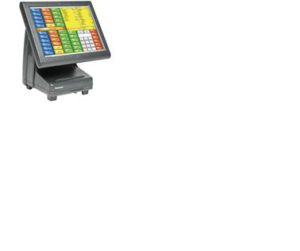JS-925W – LiteRay

SPECIFICATIONS:
Item Specification
Model 12.1” TFT-LCD installed model 15” TFT-LCD installed model
CPU
Type Intel ATOM N270 Fanless
Frequency 1.6GHz
Main
Memory
Capacity
Standard: 1GB (use 1 SO-DIMM slot)
Maximum: 2GB
Slot 1 x DDR2 SO-DIMM slots, 200pin
Type DDR2-400/533/667 supported
Supported OS
Windows XP SP3 or later
WEPOS 1.1 SP3 or later
POS Ready 2009 or later
Linux kernel 2.6, Slackware Ver. 12.0
Storage I/F
Type 1 x 2.5” HDD or SSD (2 x 2.5” function is optional)
Interface SATA
RAID function RAID0, RAID1 (optional function)
Other Disk
Drive(Option)
Floppy Disk Drive External USB FDD interface is supported
CD/DVD-ROM Drive External USB DVD/CD-ROM interface is supported
Display
Type TFT type LCD with dual back light
Resolution 800×600 (SVGA) 1024 x 768 (XGA)
Display size 12.1” 15”
Colors 260,000 colors or more
Touch Panel
Type 5-wire resistive
Size 12.1” LCD type 15” LCD type
Interface Serial
Life 10 million touches or more
Local Area Network Ethernet (10BASE-T/100BASE-TX) Note: Wake On LAN supported
I/O ports
Serial
4 ports 9pin D-SUB male located on I/O panel
COM1, COM2, COM3, COM4
Note:
– COM1 and COM2 are powered
– Powered must be selectable among RI, +5V and +12V using 9 pin
Video
1 port 15pin D-SUB female located on I/O panel
Note: dual display function is supported
LAN
1 port RJ-45 located on I/O panel
Note: There is a status LED in the connector
USB 2.0
– 2 USB ports located on I/O panel
– 2 USB ports located on display unit and on rear. (display x 1, rear x 1)
– 3 optional USB ports located on communication board and USB HUB board
– (2 x I/O expansion board, 1 x display unit)
Cash Drawer RJ type drawer located on I/O panel
Expansion I/F
Communication board (optional unit)
(1) JS-925CB-010
Expansion I/O I/F + speaker
Included interface signal
– Line-OUT 1 port
– USB 2.0 2 ports
– DIN type drawer 1 port
Note: The power of +12V, 1A is required to drive DIN type cash drawer
Switch 1 power switch
LED
1 power status located on front panel
1 HDD status located on front panel
1 LAN status located on front panel
Power
Supply
Input AC100V-240V, 50/60 Hz
Output +12V
Backup
Battery I/F
Optional
Note: retention time: 2 minutes
Optional
Peripherals
Communication board
JS-925CB-010
Expansion I/O I/F + Speaker
I/F : Expansion I/F
– Line-OUT 1port
– USB 2.0 2ports
– Din type drawer 1port (Same as JS-950WS)
Note: Power +12V, 1A is required to drive DIN type cash drawer
Backup Battery
JS-925BT
Backup battery for AC power failure
Note: Retention time: 2 minutes
Battery charge function
Magnetic Card Reader
JS-950MG-010
Magnetic strip reader module : JIS D, D type
I/F : USB (internal connector for MSR) Virtual COM
USB Extension board
JS-925HU-010
USB-HUB board
Use for 2USB port of display unit
12.1”: Approx W320 mm x D263 mm x H392 mm
Approx W12.6 in x D10.35 in x H15.4 in
15”: Approx W364 mm x D291 mm x H413 mm
Approx W14.3 in x D11.45 in x H16.25 in
Panasonic is now introducing the new Lite-ray POS workstation. Based on Stingray, Lite-ray combines Panasonic’s proven performance with an open platform to accommodate virtually any POS software application in a cost-efficient package for small business operations. Its extensive features include a 15″ display, a host of optional security features, MSR placement, spill and dirt resistant construction, an all-in-one fanless design with a small footprint and a rear static pop display holder with a two line rear display. In addition, Lite-ray features a 3-year warranty.
It’s an easy decision when you think about it. Lite-ray, is engineered to provide just the features you need, for virtually any application. When you take a closer look at Lite-ray, you’ll see why less is just right for you.
MSR SETUP:
Set Terminals OPOS Utility Card Reader to : MSR-250
In MD OPOS Utility set the same – MSR250
In MD – WS Options – Device – OPOS
Line Display Setup:
Set the Terminals OPOS Utility to: “2 Bytes UFD” (leave default to serial com# 6)
In MD OPOS Utility set to: JS-925WS_VFD2L
WS Options – Map Port #4 TO COM 6
Then set up the device in WS options as: Line Display – Serial # 4 – Use driver: Epson ESC/POS
